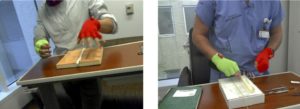Paper in IJCARS (2016) on “Automated video-based assessment of surgical skills for training and evaluation in medical schools”
Paper
Abstract
Purpose: Routine evaluation of basic surgical skills in medical schools requires considerable time and effort from supervising faculty. For each surgical trainee, a supervisor has to observe the trainees in- person. Alternatively, supervisors may use training videos, which reduces some of the logistical overhead. All these approaches, however, are still incredibly time consuming and involve human bias. In this paper, we present an automated system for surgical skills assessment by analyzing video data of surgical activities.
Method : We compare different techniques for video-based surgical skill evaluation. We use techniques that capture the motion information at a coarser granularity using symbols or words, extract motion dynamics using textural patterns in a frame kernel matrix, and analyze fine-grained motion information using frequency analysis. Results: We were successfully able to classify surgeons into different skill levels with high accuracy. Our results indicate that fine-grained analysis of motion dynamics via frequency analysis is most effective in capturing the skill relevant information in surgical videos.
Conclusion: Our evaluations show that frequency features perform better than motion texture features, which in turn perform better than symbol/word-based features. Put succinctly, skill classification accuracy is positively correlated with motion granularity as demonstrated by our results on two challenging video datasets.


